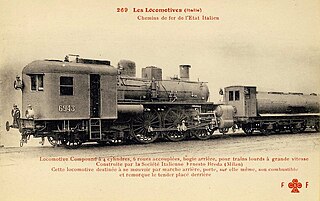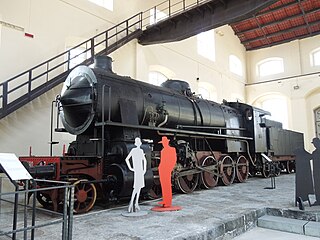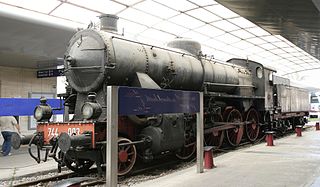
The Ferrovie dello Stato Class 685 is a class of 2-6-2 'Prairie' express train steam locomotives. These are colloquially known as Regine, mirroring their fame as one of the most successful and appreciated Italian steam locomotives.

The Ferrovie dello Stato Italiane Class 691 is a class of 4-6-2 'Pacific' locomotives; they were the fastest and most powerful locomotives ever built for the Italian railways.

The Rete Adriatica Class 500, classified after 1905 in the Ferrovie dello Stato Italiane as Class 670 was an unorthodox and iconic cab forward 4-6-0 (2'C) steam locomotive.

The Ferrovie dello Stato Italiane Class 690 was a 4-6-2 'Pacific' steam locomotive for express trains.

The Ferrovie dello Stato Italiane Class 470 is a 0-10-0 steam locomotive.

The Ferrovie dello Stato Class 480 is a 2-10-0 steam locomotive.

The Ferrovie dello Stato Italiane Class 552, formerly Rete Adriatica Class 180 bis, is a 4-4-0 steam locomotive; it was the final development in Italy of the 'American' express locomotive type.

The Ferrovie dello Stato Italiane Class 600, formerly Rete Adriatica Class 380 and Società per le Strade Ferrate Meridionali Class 380, is a 2-6-0 'Mogul' steam locomotive; it is considered by some as the first Italian modern steam locomotive.

The Ferrovie dello Stato Italiane Class 835 is a 0-6-0T steam locomotive; it was the standard steam shunter of the FS.

The Ferrovie dello Stato Italiane Class 290, formerly the Rete Adriatica Class 350 bis, is a 0-6-0 steam locomotive.

The Ferrovie dello Stato Italiane Class 420, formerly SFAI Class 1200, Rete Adriatica Class 420 and Rete Mediterranea Class 480, was a 0-8-0 steam locomotive.
The Ferrovie dello Stato Italiane Class 310, formerly Rete Mediterranea Class 380, was a 0-6-0 steam locomotive; they were the first Italian as-built compound locomotives.

The Ferrovie dello Stato Class 741 is a class of 2-8-0 'Consolidation' steam locomotives, rebuilds from the FS Class 740 with a Franco-Crosti boiler; it was the last class of steam locomotives introduced in Italy.

The Mastodonte dei Giovi was a special double steam locomotive built specifically for use on the difficult Apennine stretch of the new Turin - Genoa railway line, inaugurated in 1853.

FS Class 170 was a class of 2-4-0 steam locomotives acquired by Italian State Railways (FS) from Rete Mediterranea (RM) on nationalization in 1905.
Locomotives SFAI 250-258 were 0-4-2 steam locomotives of the Società per le strade ferrate dell'Alta Italia (SFAI).
FS Class 396 was a class of 0-6-0 steam locomotives originally built for the Victor Emmanuel Railway (VE). They were designed for hauling passenger trains and were nicknamed "Mammoth".

FS Class 400 were steam locomotives of French construction, built for service in Italy. They were 0-8-0 tender locomotives with two outside cylinders.
The Ferrovie dello Stato Class 745 was a class of 2-8-0 'Consolidation' steam locomotives.

The Ferrovie dello Stato Class 744 is a class of 2-8-0 steam locomotives; they were the last orthodox steam locomotives built for the FS.
















